Here in the Pacific Northwest, we have Paper Wasps, Yellowjackets, Mud Daubers, and Hornets. There are a multitude of others (the overwhelming majority) on the fringe that we typically don’t encounter, but the problem is apparent: In Oregon, many different types of wasps can sting you when harassed.
While the different species of bees serve an enormously important role for the environment and our everyday lives, a few wasp species varieties can be a source of annoyance and danger, especially when they become excessively common… and with all of them looking so similar, it can be hard to tell which bugs have paid your backyard or picnic a visit.
Nobody wants to take any unnecessary chances with these stinging pests, so we’ve prepared a guide to help you distinguish between the local wasps of Oregon.
See Also: Oregon Bee Relocation
Wasp Identification: Differentiating Common Types of Wasps
Let’s look at some of the most common types of wasps found in the United States and detail their physical characteristics so that you can confidently identify them. So when you come across an odd-looking wasp, at least you have a handful of information about these complex insects.
Paper Wasps
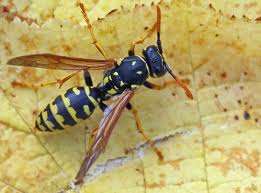
Paper wasps are named for their habit of creating papery nests in visible locations. While yellow jackets will build nests below ground or high in trees (out of the same papery pulp substance), paper wasps prefer to build their nests less hidden, on branches, and especially under the eaves of your home, inside dry electrical outlet boxes, and even inside barbecue grills when not in use. Practically anywhere, they can start their nest building in a dry and protected location.
These hives are most commonly (but only sometimes) found on the south-facing eaves of buildings. You’ve likely seen their handiwork before:

Distinct Paper Wasp Behavior and Preference
There are many varieties of paper wasps, but most in the Pacific Northwest look very similar. Yellow jackets and paper wasps are quite similar, but are easily differentiated by their body shape, behavior, and nest-building preferences. The latter can be aggressive, though not on the same level as the rage-filled yellow jackets.
Paper wasp hives contain small chambers where larvae grow, bringing about new wasps as they mature. Like most wasps, only the queens survive in the winter, and new queens spread out in the spring to create new nests.
Paper wasps start a new nest yearly, and only the queen survives the winter. These guys aren’t all bad since they kill many flies and other insect pests. The wasp’s nest is simple, with only one layer that opens downward. Cells are uncovered, and nests seldom reach a size greater than 8 inches across with 200 workers.

Yellow Jacket
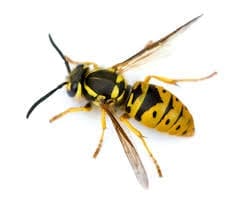
Perhaps the most feared barbeque visitor, yellow jackets seem to be able to sniff out a tasty watermelon or a juicy hamburger from a block away. Surprisingly, they often live underground or inside wall voids. Yellow jackets construct large, paperlike nests similar to the hornet’s, but their nests can grow to several thousand workers within one season in warmer climates. In the Pacific Northwest they rarely exceed a few hundred.
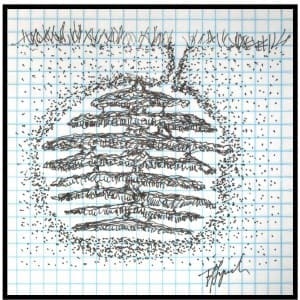
Dangerous and Territorial Wasps
The most common way humans provoke these wasp types into stinging and aggression is by accidentally stepping on or near the nest entrance or physically bothering one on accident (such as pushing a lawn mower over a hive opening).
Yellow jackets are fiercely territorial and considered highly aggressive. Unlike friendly honey bees, they (and all other wasps) can sting repeatedly, and some can even bite. If you see yellow and black wasps leaving and returning to a hole in the ground or other soft material (like mulch or a mound of debris), you’re likely dealing with yellow jackets. Care should be taken around the nest, as they are provoked quite easily and have been known to sting without noticeable provocation.
New queens are produced within the colony late in the summer, so they demand sugars from the workers for sustenance. These worker yellow jackets forage aggressively for things like soda pop, beer, watermelon, and other favorite picnic items.
Yellow jackets are considered one of the most dangerous wasps, as their sting can cause life-threatening allergic reactions in some victims. Seek help immediately when encountering wasp sting-related emergencies.
Mud Dauber (Mud Wasp)
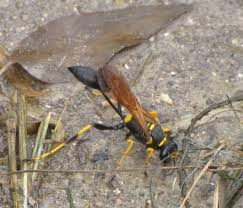
Although you are very unlikely to get stung by a mud dauber, these wasps appear frightening due to their long legs, extended abdomen, and heavy black coloration. They are often found buzzing around puddles, ponds, and sprinklers collecting mud to build their nests; thus, the name “mud dauber wasps” applies.
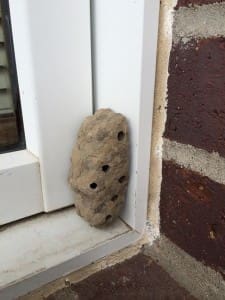
Mud dauber wasp nests are often constructed over doorways, under eaves, and outdoor seating areas. The nests are packed with dead insects as food for the emerging young mud daubers when hatching time comes. Mud dauber wasps typically show very little aggression, unlike yellow jackets and hornets. Therefore, they are typically not considered a significant nuisance pest. If left undisturbed, the nests will rarely cause any structural damage to a home or property.
Bald-Faced Hornets

The bald-faced hornet is somewhat misnamed; contrary to its label, it is not an authentic hornet. In fact, it belongs to the family of yellow jackets and wasps. You don’t want to mess with a bald-faced hornet because they’re known for being extra fierce. They can sting through bee suits and shoot their venom (as our technicians have discovered), often aiming for the eyes. Their soccer-ball-sized paper nests house enough workers to do a lot of stinging.
Bald-faced hornets are sometimes referred to as “black jackets.” They differ in appearance, mainly in color, being white and black rather than yellow and black and are much bigger. They are incredibly aggressive and tend to make ball-shaped nests. They build their nests in trees or under the eaves of your home. If agitated, they will attack, and the wasp stings can be numerous. Don’t try to remove these nests unless you wear extensive protective gear or let a professional do it.
See Also: Oregon Hornet Control
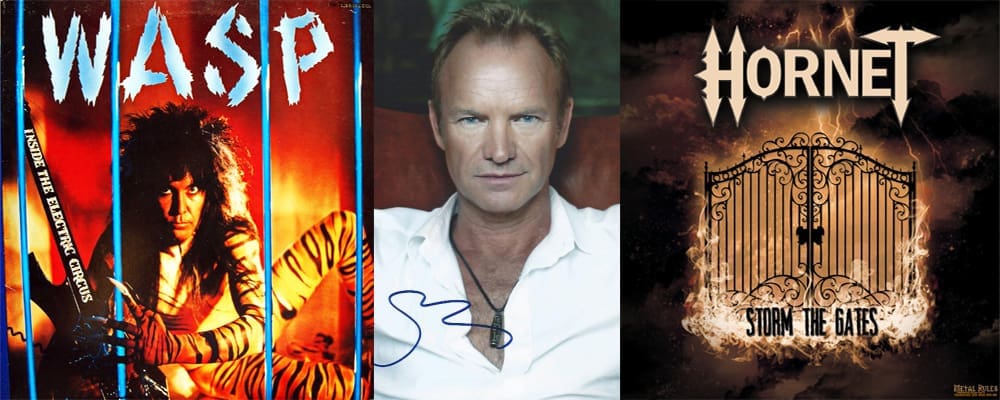
Fun fact: Most wasps and hornets are highly attracted to soda cans and metallic chip bags and even have favorite musicians and musical groups.
Queen Killer
When these wasp species reach adulthood and are ready to fan out, looking to build new nests, they will often kill their queen to give new queens a reproductive advantage. It takes only six days for a queen’s eggs to hatch and another eight for the larvae to reach adulthood. A colony can begin and spread to other nests in only two weeks.
One Solution for All Types of Wasps
Due to the possibility of allergic reactions and other severe harm from wasp and bee stings, control for all varieties of wasps and bees is best left to trained pest service technicians. Professionals can access the protective gear, tools, methods, and agents needed to entirely rid your home of these aggressive pests.
When dealing with wasps and bees, early morning or cooler evening is the best time to approach. Still, a trained professional with access to various tools, methods, and agents is often needed to entirely rid your home of these aggressive pests.
Unparalleled Extermination Service
We are confident that every wasp, hornet, and bee extermination service will be 100% effective. We kill the wasps, remove the nests, and then with our ongoing service package, ensure they never return. Find out more, and schedule a treatment today to eliminate your wasp woes for good!
For more on problems with bees, check out our video on Swarming Behavior, which is very common in the late Spring through Summer:

Call in the experts to handle your wasp problems. Bug Zapper Pest Control knows wasps in Oregon. Our fast, local service technician is ready to help you manage your wasp problems.

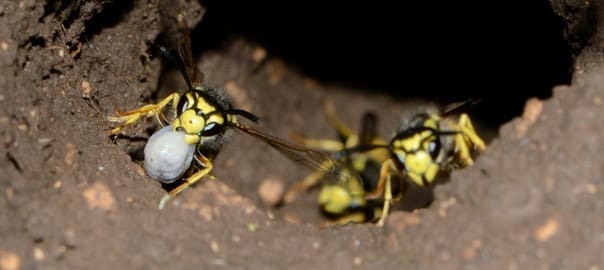
 All About German Cockroaches
All About German Cockroaches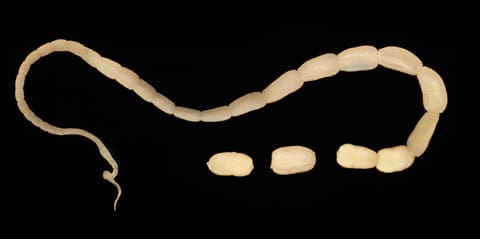 Danger! Fleas Spread Tapeworm!
Danger! Fleas Spread Tapeworm! Getting Rid of Mice
Getting Rid of Mice How to Prevent Bed Bug Infestation While Traveling
How to Prevent Bed Bug Infestation While Traveling When Are Fleas Most Active?
When Are Fleas Most Active?